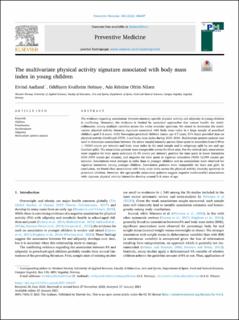| dc.contributor.author | Aadland, Eivind | |
| dc.contributor.author | Holmøy, Oddbjørn Kvalheim | |
| dc.contributor.author | Nilsen, Ada Kristine Ofrim | |
| dc.coverage.spatial | Norway, Sogn og Fjordane | en_US |
| dc.date.accessioned | 2021-03-19T09:24:05Z | |
| dc.date.available | 2021-03-19T09:24:05Z | |
| dc.date.created | 2021-01-25T10:57:37Z | |
| dc.date.issued | 2021 | |
| dc.identifier.citation | Aadland, E., Holmøy, O. K., & Nilsen, A. K. O. (2021). The multivariate physical activity signature associated with body mass index in young children. Preventive Medicine, 145. | en_US |
| dc.identifier.issn | 0091-7435 | |
| dc.identifier.uri | https://hdl.handle.net/11250/2734390 | |
| dc.description.abstract | The evidence regarding associations between intensity-specific physical activity and adiposity in young children is conflicting. Moreover, the evidence is limited by analytical approaches that cannot handle the multicollinearity among multiple variables across the entire intensity spectrum. We aimed to determine the multivariate physical activity intensity signature associated with body mass index in a large sample of preschool children aged 3–6 years. 1182 Norwegian preschool children (mean age 4.7 years, 51% boys) provided data on physical activity (ActiGraph GT3X+) and body mass index during 2015–2016. Multivariate pattern analysis was used to determine associations between the entire triaxial intensity spectra (time spent in intensities from 0-99 to ≥ 15000 counts per minute) and body mass index in the total sample and in subgroups split by sex and age (median split). The association patterns were comparable across the three axes. For the vertical axis, associations were negative for time spent sedentary (0–99 counts per minute), positive for time spent in lower intensities (100–2999 counts per minute), and negative for time spent in vigorous intensities (4000–12,999 counts per minute). Associations were stronger in older than in younger children and no associations were observed for vigorous intensities among younger children. Association patterns were comparable for boys and girls. In conclusion, we found clear associations with body mass index across the physical activity intensity spectrum in preschool children. However, the age-specific association patterns suggest negative (unfavorable) associations with vigorous physical activity intensities develop around 5–6 years of age. | en_US |
| dc.language.iso | eng | en_US |
| dc.publisher | Elsevier | en_US |
| dc.rights | Navngivelse 4.0 Internasjonal | * |
| dc.rights.uri | http://creativecommons.org/licenses/by/4.0/deed.no | * |
| dc.title | The multivariate physical activity signature associated with body mass index in young children | en_US |
| dc.type | Peer reviewed | en_US |
| dc.type | Journal article | en_US |
| dc.description.version | publishedVersion | en_US |
| dc.rights.holder | © 2021 The Authors | en_US |
| dc.source.volume | 145 | en_US |
| dc.source.journal | Preventive Medicine | en_US |
| dc.identifier.doi | 10.1016/j.ypmed.2021.106437 | |
| dc.identifier.cristin | 1878219 | |
| dc.source.articlenumber | 106437 | en_US |
| cristin.ispublished | true | |
| cristin.fulltext | original | |
| cristin.qualitycode | 2 | |

